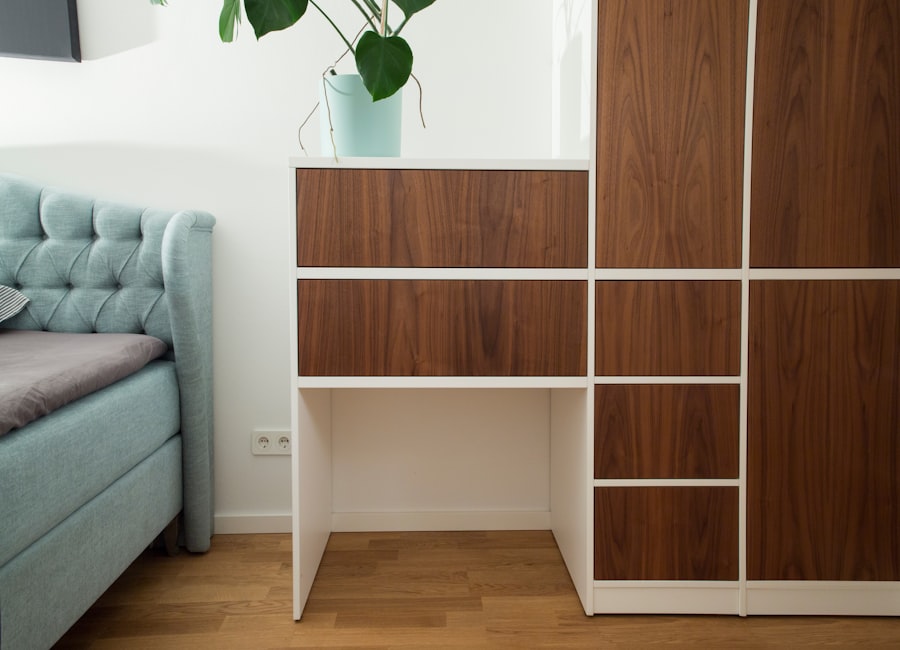The history of millwork and cabinetry is a rich tapestry woven through centuries of craftsmanship, innovation, and evolving design aesthetics. Millwork, which encompasses a variety of wood products such as moldings, trim, and cabinetry, has its roots in ancient civilizations. The Egyptians, for instance, were known for their intricate wooden furniture and decorative elements, often using local woods like sycamore and cedar.
As societies progressed, so did the techniques and styles of woodworking. The Middle Ages saw the rise of guilds in Europe, where skilled artisans honed their craft, producing elaborate wooden structures and furnishings that reflected the wealth and status of their patrons. The Renaissance period marked a significant turning point in the history of cabinetry.
This era celebrated artistry and individual expression, leading to the creation of ornate cabinets that served not only functional purposes but also as status symbols. The introduction of new tools and techniques, such as the use of dovetail joints and intricate carvings, allowed craftsmen to push the boundaries of design. By the 18th century, the American colonies began to develop their own distinct styles, influenced by European trends yet adapted to local tastes and available materials.
The Federal style emerged, characterized by its elegance and symmetry, while the Shaker movement emphasized simplicity and functionality. These historical developments laid the groundwork for modern millwork and cabinetry, which continue to evolve while honoring traditional craftsmanship.
Key Takeaways
- Custom millwork and cabinetry have a rich history rooted in traditional craftsmanship.
- They play a crucial role in enhancing interior design by adding personalized and functional elements.
- Crafting custom pieces involves careful planning, skilled woodworking, and selecting appropriate materials.
- Modern technology has significantly improved precision and efficiency in woodworking processes.
- Collaborating with professional woodworkers ensures quality results and helps tailor designs to specific architectural styles.
The Importance of Custom Millwork and Cabinetry in Interior Design
Custom millwork and cabinetry play a pivotal role in interior design, serving as both functional elements and aesthetic focal points within a space. Unlike mass-produced options, custom pieces are tailored to fit specific dimensions, styles, and personal preferences, allowing homeowners to create unique environments that reflect their individuality. This bespoke approach not only enhances the overall design but also maximizes space efficiency.
For instance, a custom-built bookshelf can be designed to fit snugly into an awkward alcove, transforming an underutilized area into a stunning display of literature and decor. Moreover, custom millwork adds a layer of sophistication that elevates the ambiance of any room. High-quality cabinetry can serve as a statement piece in kitchens, bathrooms, or living areas, showcasing exquisite craftsmanship and attention to detail.
The choice of finishes, hardware, and design elements can harmonize with other aspects of the interior, creating a cohesive look that resonates with the homeowner’s vision. In contemporary design, where minimalism often reigns supreme, custom millwork can introduce warmth and texture through natural wood grains and intricate patterns, striking a balance between modernity and tradition.
The Process of Crafting Custom Millwork and Cabinetry

The journey from concept to completion in crafting custom millwork and cabinetry is a meticulous process that involves several stages. Initially, it begins with consultation between the client and the woodworker or designer. During this phase, discussions revolve around the client’s needs, preferences, and budget.
Detailed measurements are taken to ensure that the final product will fit seamlessly into the designated space. This collaborative approach allows for the incorporation of personal touches that make each piece truly one-of-a-kind. Once the design is finalized, the next step involves selecting the appropriate materials.
This choice is crucial as it impacts both the aesthetic appeal and durability of the finished product. After material selection, skilled artisans begin the woodworking process. This includes cutting, shaping, sanding, and finishing the wood to achieve the desired look and feel.
Advanced techniques such as CNC machining may be employed for precision cuts and intricate designs. Finally, installation is carried out with great care to ensure that every piece fits perfectly within its environment. This comprehensive process not only showcases the craftsmanship involved but also highlights the importance of collaboration between designers and artisans in bringing a vision to life.
Choosing the Right Wood for Your Custom Millwork and Cabinetry
| Wood Type | Hardness (Janka Scale) | Grain Pattern | Durability | Workability | Common Uses | Cost Level |
|---|---|---|---|---|---|---|
| Oak (Red & White) | 1290 – 1360 | Prominent, open grain | High | Good | Cabinetry, flooring, millwork | Medium |
| Maple (Hard Maple) | 1450 | Fine, uniform grain | Very High | Moderate | Cabinetry, furniture, millwork | Medium-High |
| Cherry | 950 | Fine, smooth grain | Moderate | Excellent | Cabinetry, furniture | High |
| Walnut | 1010 | Straight to wavy grain | Moderate | Good | High-end cabinetry, millwork | High |
| Pine (Southern Yellow) | 420 | Straight, knotty grain | Low to Moderate | Excellent | Cabinetry, trim, millwork | Low |
| Mahogany | 800 – 900 | Fine, straight grain | High | Good | Luxury cabinetry, millwork | High |
| Birch | 1260 | Fine, even grain | Moderate | Good | Cabinetry, furniture | Medium |
Selecting the right wood for custom millwork and cabinetry is a critical decision that influences both aesthetics and functionality. Different types of wood offer varying characteristics in terms of grain patterns, color variations, durability, and workability. Hardwoods such as oak, maple, cherry, and walnut are popular choices for cabinetry due to their strength and resistance to wear.
Oak, for instance, is known for its prominent grain patterns and durability, making it ideal for high-traffic areas like kitchens. Maple offers a smooth surface with subtle grain variations that can be beautifully stained or painted. In contrast, softwoods like pine or cedar may be chosen for their lighter weight and ease of manipulation.
Pine is often favored for rustic or farmhouse-style designs due to its warm tones and knots that add character. Cedar is prized for its natural resistance to moisture and insects, making it an excellent choice for outdoor cabinetry or spaces prone to humidity. Beyond aesthetics and durability, considerations such as sustainability also play a role in wood selection.
Many homeowners are now opting for reclaimed wood or sustainably sourced materials to minimize environmental impact while still achieving stunning results.
The Role of Technology in Modern Woodworking
The woodworking industry has undergone a significant transformation with the advent of technology. Modern woodworking combines traditional craftsmanship with advanced tools and techniques that enhance precision and efficiency. Computer Numerical Control (CNC) machines have revolutionized the way custom millwork is produced.
These machines allow for intricate designs to be cut with remarkable accuracy, reducing waste and ensuring consistency across multiple pieces. This technology enables artisans to create complex patterns that would be challenging to achieve by hand. Additionally, software programs designed for woodworking facilitate the design process by allowing clients to visualize their projects in 3D before production begins.
This capability not only aids in making informed decisions about design elements but also helps identify potential issues early on in the process. Furthermore, advancements in finishing techniques have led to improved durability and aesthetics. For example, water-based finishes are now widely used due to their low environmental impact while providing excellent protection against wear and tear.
As technology continues to evolve, it opens up new possibilities for creativity in woodworking while maintaining a strong connection to traditional craftsmanship.
Incorporating Custom Millwork and Cabinetry into Different Architectural Styles

Custom millwork and cabinetry can seamlessly integrate into various architectural styles, enhancing their unique characteristics while providing functional solutions tailored to each design ethos. In traditional homes characterized by classic elements such as crown moldings and wainscoting, custom cabinetry can be designed to complement these features with ornate details that echo historical craftsmanship. For instance, a Victorian-style home may benefit from intricately carved wooden mantels or built-in bookcases that reflect the ornate nature of the architecture.
Conversely, contemporary architectural styles often embrace minimalism and clean lines. In such settings, custom millwork can take on a more streamlined appearance with flat-panel doors and sleek finishes that emphasize simplicity. A modern kitchen might feature cabinetry with handle-less designs or integrated lighting that highlights the beauty of natural wood grains without overwhelming the space.
Additionally, transitional styles that blend traditional and contemporary elements can utilize custom millwork to create harmony between differing design philosophies. By thoughtfully incorporating custom pieces into various architectural styles, homeowners can achieve a cohesive look that enhances both functionality and aesthetic appeal.
The Benefits of Investing in Custom Millwork and Cabinetry
Investing in custom millwork and cabinetry offers numerous advantages that extend beyond mere aesthetics. One of the most significant benefits is the ability to maximize space utilization effectively. Custom pieces can be designed to fit specific dimensions or unique layouts within a home, ensuring that every inch is utilized efficiently without compromising on style or functionality.
This is particularly advantageous in smaller spaces where off-the-shelf solutions may fall short. Moreover, custom millwork often translates into higher quality materials and craftsmanship compared to mass-produced alternatives. Artisans take pride in their work, ensuring that each piece is built to last using durable materials that withstand daily wear and tear.
This investment not only enhances the immediate environment but also adds value to the property over time. Potential buyers often appreciate high-quality custom features when evaluating homes on the market. Additionally, custom millwork allows homeowners to express their personal style through tailored designs that reflect their tastes and preferences—creating spaces that feel uniquely theirs.
Working with a Professional Woodworker: Tips and Considerations
When embarking on a project involving custom millwork or cabinetry, collaborating with a professional woodworker is essential for achieving desired results. One of the first considerations should be researching potential candidates thoroughly; reviewing portfolios can provide insight into their craftsmanship style and capabilities. It’s beneficial to seek recommendations from friends or family who have undertaken similar projects or consult online reviews for additional perspectives.
Once you’ve identified potential woodworkers, scheduling consultations is crucial for discussing your vision in detail. During these meetings, it’s important to communicate your ideas clearly while remaining open to suggestions from the professional based on their expertise. Discussing budget constraints upfront can help align expectations regarding what is feasible within your financial parameters without compromising quality or design integrity.
Additionally, understanding timelines is vital; custom projects often require time for design iterations, material sourcing, fabrication, and installation. Establishing clear communication throughout each phase ensures that any adjustments or concerns are addressed promptly—ultimately leading to a successful collaboration that results in stunning custom millwork tailored specifically for your home’s needs. In conclusion, investing time in selecting the right professional woodworker can significantly impact your project’s outcome—ensuring that your vision is realized through expert craftsmanship while enhancing your living space with beautiful custom millwork and cabinetry tailored just for you.



